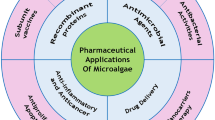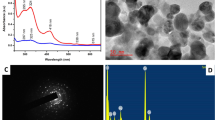Abstract
The aim of this investigation was to evaluate the in vitro cytotoxic effect and antiviral properties of 7-keto-stigmasterol from the crude extract of the green Antarctic alga Prasiola crispa in dichloromethane against the replication of equine herpesvirus 1 (EHV-1), a worldwide enzootic etiological agent of clinical signs such as abortion, as well as neurological and respiratory diseases. Extract samples were fractionated in silica gel of 70–230 and 230–400 mesh and identified with 1H and 13C nuclear magnetic resonance spectroscopy. The cytotoxic effect was assayed with 3-(4,5-dimethylthiazol-2yl)-2,5diphenyl tetrazolium bromide (MTT), neutral red, and violet crystal in rabbit kidney (RK-13) cells treated with 12.5, 25, 50, 100, and 200 μM of 7-keto-stigmasterol. The CC50 of MTT, neutral red, and violet crystal were 1884 ± 7.5, 799 ± 6.7, and 1002 ± 6.3 μM, respectively. To characterize the antiviral action of 7-keto-stigmasterol and acyclovir, RK-13 cells were inoculated with 200 plaque-forming units of EHV-1 and treated with 12.5, 25, and 50 μM of both compounds and the EC50 value (39 ± 6 μM) of 7-keto-stigmasterol protected 50 % of RK-13 cells, with a selectivity index of 47, 20, and 26 for MTT, neutral red, and violet crystal, respectively. However, acyclovir showed no antiviral activity on the EHV-1 variant studied. EHV-1 was inactivated by mixing a viral suspension with 1 × 104 plaque-forming units with different concentrations of 7-keto-stigmasterol and incubated at room temperature (24 °C) for 1 h; a control of untreated infected cells was performed under the same conditions. The samples were then diluted, and the residual infectivity was determined by a plaque assay. The percentages of EHV-1 inactivation with 7-keto-stigmasterol were 12.5 (51 %), 25 (67 %), 50 (91 %), and 100 μM (100 %). The inactivation of EHV-1 by direct interaction with 7-keto-stigmasterol probably interferes with EHV-1 attachment to cells with irreversible inactivation of virus infectivity.



Similar content being viewed by others
References
Azab W, Osterrieder N (2012) Glycoproteins D of equine herpesvirus type 1 (EHV-1) and EHV-4 determine cellular tropism independently of integrins. J Virol 86:2031–2044
Azab W, Lehmann MJ, Osterrieder N (2013) Glycoprotein H and alpha4beta1 integrins determine the entry pathway of alphaherpesviruses. J Virol 87:5937–5948
Campadelli-Fiume G, Amasio M, Avitabile E, Cerretani A, Forghieri C, Gianni T, Menotti L (2007) The multipartite system that mediates entry of herpes simplex virus into the cell. Rev Med Virol 17:313–326
Carvalho LR, Roque NF (2000) Fenóis halogenados e ou sulfatados de macroalgas marinhas. Quim Nov. 23:757–764
Cheng HY, Lin TC, Yang CM, Wang KC, Lin LT (2004) Putranjivain a from Euphorbia jolkini inhibits both virus entry and late stage of replication of herpes simplex virus type 2 in vitro. J Antimicrob Chemother 53:577–583
Costa EA, Rosa R, Oliveira TS, Furtini R, Fonseca Júnior AA, Paixão TA, Santos R (2015) Diagnóstico etiológico de enfermidades do sistema nervoso central de equinos no estado de Minas Gerais, Brasil. Arq Bras Med Vet Zootec 67:391–399
Demel RA, Bruckdorfer KR, van Deenen LL (1972) The effect of sterol structure on the permeability of lipomes to glucose, glycerol and Rb+. Biochim Biophys Acta 255:321–330
Dunowska M (2014) A review of equid herpesvirus 1 for the veterinary practitioner. Part B: Pathogenesis and epidemiology. NZ Vet J 62:179–188
Fan Q, Amen M, Harden M, Severini A, Griffiths A, Longnecker R (2012) Herpes B virus utilizes human nectin-1 but not HVEM or PIL Ralpha for cell-cell fusion and virus entry. J Virol 86:4468–4476
Fautz R, Husein B, Hechenberger C (1991) Application of the neutral red assay to monolayer cultures of primary hepatocytes rapid colorimetric viability determination for the unscheduled DNA synthesis test (UDS). Mutat Res 253:173–179
Fernandes DR, Peruzii VO, Yoneshigue-Valentin Y (2014) Seaweed biotechnology in Brazil: six decades of studies on natural products and their antibiotic and other biological activities. J Appl Phycol 26:1923–1937
Geraghty RJ, Krummenacher C, Cohen GH, Eisenberg RJ, Spear PG (1998) Entry of alphaherpesviruses mediated by poliovirus receptor related protein 1 and poliovirus receptor. Science 280:1618–1620
Goodman LB, Wimer C, Dubovi EJ, Gold C, Vagner B (2012) Immunological correlates of vaccination and infection for equine herpesvirus 1. Clin Vaccine Immunol 19:235–241
Griffon G, Marchal C, Merlin JL, Marchal S, Parache RM, Bey P (1995) Radiosensitivity of multicellular tumour spheroids obtained from human ovarian cancers. Eur J Cancer 31A:85–91
Ibñez E, Cifuentes A (2013) Benefits of using algae as natural sources of functional ingredients. J Sci Food Agric 93:703–709
Kosugi M, Katashima Y, Aikawa S, Tanabe Y, Kudoh S, Kashino Y, Koike H, Satoh K (2010) Comparative study on the photosynthetic properties of Prasiola (Chlorophyceae) and Nostoc (Cyanophyceae) from Antarctic and non-Antarctic sites. J Phycol 46:466–476
Kovačik L, Batista AP (2001) Green alga Prasiola crispa and its lichenized form Mastodia tesselata in Antarctic environment: general aspects. Nova Hedwigia Beih 123:465–478
Kydd JH, Townsend HGG, Hannant D (2006) The equine immune response to equine herpesvirus-1: the virus and its vaccines. Vet Immunol Immunopathol 111:15–30
Laval K, Favoreel HW, Poelaert KC, Van Cleemput J, Nauwynck HJ (2015) Equine herpesvirus type 1 (EHV-1) enhances viral replication in CD172a+ monocytic cells upon adhesion to endothelial cells. J Virol doi:10.1128/JVI.01589-15 JVI.01589-15
Lud D, Buma AGJ, van de Poll W, Moerdijk TCW, Huiskes AHL (2001) DNA damage and photosynthetic performance in the Antarctic terrestrial alga Prasiola crispa spp. antarctica (Chlorophyta) under manipulated UV-B radiation J Phycol 37:459–467
Mayer AM, Lehmann VK (2001) Marine pharmacology in 1999: antitumor and cytotoxic compounds. Anticancer Res 21:2489–2500
Mori E, Borges AS, Delfiol DJ, Oliveira Filho JP, Gonçalves RC, Cagnini DQ, Lara MC, Cunha EM, Villa Lobos EM, Nassar AF, Castro AM, Brandao PE, Richtzenhain LJ (2011) First detection of the equine herpesvirus neuropathogenic variant in Brazil. Rev Sci Tech 30:949–954
Mosmann T (1983) Rapid colorimetric assay for cellular growth and survival: Application to proliferation and cytotoxicity assays. J Immunol Meth 65:55–63
Osterrieder N (1999) Construction and characterization of an equine herpesvirus 1 glycoprotein C negative mutant. Virus Res 59:165–177
Parish EJ, Li S, Bell AD (2008) Chemistry of waxes and sterols. In: Akoh CC, Min DB (eds) Food lipids: Chemistry, nutrition, and biotechnology. CRC Press, Boca Raton, pp. 106–123
Petrera E, Níttolo AG, Alché LE (2014). Antiviral action of synthetic stigmasterol derivatives on herpes simplex virus replication in nervous cells in vitro. BioMed Res Int Article ID 947560.
Pinto AMV, Leite JPG, Ferreira WJ, Cavalcanti DN, Villaça RC, Giongo V, Teixeira VL, Paixão ICNP (2012) Marine natural seaweed products as potential antiviral drugs against bovine viral diarrhea virus. Braz J Pharmacog 22:813–817
Pinto AMV, Leite JPG, Ramos CJB, da Fonseca RR, Teixeira VL, Paixão ICNP (2014) Anti-herpesvirus bovine type 5 activities of extracts obtained from Plocamium brasiliense. J Appl Phycol 26: 2021–2027
Rahn E, Petermann P, Hsu M, Rixon FJ, Knebel-Mörsdorf D (2011) Entry pathways of herpes simplex virus type 1 into human keratinocytes are dynamin- and cholesterol-dependent. PLoS One 6:e25464
Rindi F, Mcivor L, Sherwood AR, Friedl T, Guiry MD, Sheath RG (2007) Molecular phylogeny of the green algal order Prasiolales (Trebouxiophyceae, Chlorophyta). J Phycol 43:811–822
Rock DL (1991) Latent infection with alphaherpesviruses. In: Plowright W, Rossdale PD, Wade JF (eds) Proceedings of the Sixth International Conference on Equine Infectious Diseases R&W Publications (Newmarket) Ltd. pp. 175–180
Rusli ND, Mat KB, Harun HC (2014) A review: interactions of equine herpesvirus-1 with immune system and equine lymphocyte. Open J Vet Med 4:294–307
Salvador SS, Lemos RAA, Riet-Correa F, Roehe PM, Osório ALAR (1998) Meningoencefalite causada por herpesvírus bovino tipo 5 no Mato Grosso do Sul e São Paulo. Pesq Vet Bras 18:76–83
Saotome K, Morita H, Umeda M (1989) Cytotoxicity test with simplified crystal violet staining method using microtitre plates and its application to injection drugs. Toxicol in Vitro 3:317–321
Sasaki M, Hasebe R, Makino Y, Suzuki T, Fukushi H, Okamoto M, Matsuda K, Taniyama H, Sawa H, Kimura T (2011) Equine major histocompatibility complex class I molecules act as entry receptors that bind to equine herpesvirus-1 glycoprotein D. Genes Cells 16:343–357
Slater J (2007) Equine herpesviruses. In: Sellon DC, Long MT (eds) Equine infectious diseases, 1st edn. Saunders Elsevier, St Louis, pp. 134–153
Stasiak K, Rola J, Ploszak G, Socha W, Zmudzins JF (2015) Detection of the neuropathogenic variant of equine herpesvirus 1 associated with abortions in mares in Poland. BMC Vet Res 11:102. doi:10.1186/s12917-015-0416-7
Stengel DB, Connan S, Popper ZA (2011) Algal chemodiversity and bioactivity: sources of natural variability and implications for commercial application. Biotechnol Adv 29:483–501
Sugahara Y, Matsumura T, Kono Y, Honda E, Kida H, Okazaki K (1997) Adaptation of equine herpesvirus 1 to unnatural host led to mutationof the gC resulting in increased susceptibility of the virus to heparin. Arch Virol 142:1849–1856
Tsujimura K, Oyama T, Katayama Y, Muranaka M, Bannai H, Nemoto M, Yamanaka T, Kondo T, Kato M, Matsumura T (2011) Prevalence of equine herpesvirus type 1 strains of neuropathogenic genotype in a major breeding area of Japan. J Vet Med Sci 73:1663–1667
Vissani MA, Becerra OlguinPerglione C, Tordoya MS, Mino S, Barrandeguy M (2009) Neuropathogenic and non-neuropathogenic genotypes of equid herpesvirus type 1 in Argentina. Vet Microbiol 139:361–364
Yasuhara-Bell J, Lu Y (2010) Marine compounds and their antiviral activities. Antivir Res 86:231–240
Acknowledgments
The authors thank Brazil’s Conselho Nacional de Desenvolvimento Científico e Tecnológico (CNPq), Coordenação de Aperfeiçoamento de Pessoal de Nivel Superior (CAPES), Fundação de Amparo à Pesquisa do Estado do Rio de Janeiro (FAPERJ), Edital do Programa de Fomento à Pesquisa at the Universidade Federal Fluminense (FOPESQ-UFF), and Fundação Oswaldo Cruz (FIOCRUZ) for financial support. All authors would like to express their appreciation to Pronex-FAPERJ (grant no. E-26/110.574/2010). VLT (301420/2010-6) and ICNPP (303368/2013-6) are grateful to CNPq for Productivity Fellowships and to FAPERJ for the Cientista do Nosso Estado Fellowship (E-26/103.176/2011 and E-26/103.024/2011). CSB thanks FAPERJ for the Digital Scholarship Center Fellowship (E-26/100.770/2012), and JPGL, AMVP, and ICNPP are all grateful to FIOCRUZ and FOPESQ-UFF for financial support.
Author information
Authors and Affiliations
Corresponding author
Rights and permissions
About this article
Cite this article
dos Santos Souza Marinho, R., Ramos, C.J.B., Leite, J.P.G. et al. Antiviral activity of 7-keto-stigmasterol obtained from green Antarctic algae Prasiola crispa against equine herpesvirus 1. J Appl Phycol 29, 555–562 (2017). https://doi.org/10.1007/s10811-016-0946-9
Received:
Revised:
Accepted:
Published:
Issue Date:
DOI: https://doi.org/10.1007/s10811-016-0946-9




